The Impact of Clean and Sterile Dressing Techniques on Wound Infection Incidence
VerifiedAdded on 2022/12/26
|10
|1883
|27
AI Summary
This nursing assignment paper discusses the impact of clean and sterile dressing techniques on the incidence of wound infection. The study concludes that clean dressing is a safe and effective intervention for post-operative wounds.
Contribute Materials
Your contribution can guide someone’s learning journey. Share your
documents today.
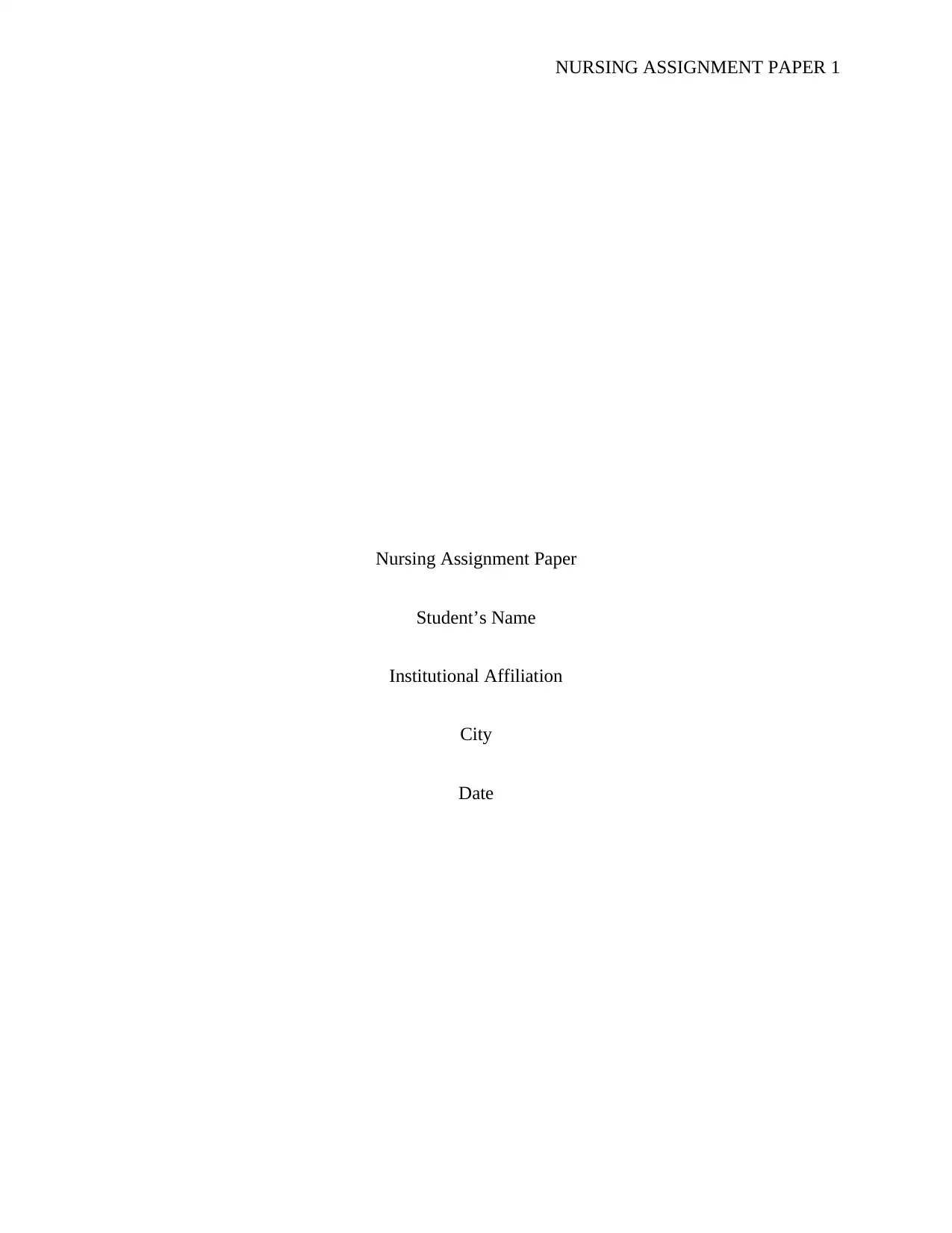
NURSING ASSIGNMENT PAPER 1
Nursing Assignment Paper
Student’s Name
Institutional Affiliation
City
Date
Nursing Assignment Paper
Student’s Name
Institutional Affiliation
City
Date
Secure Best Marks with AI Grader
Need help grading? Try our AI Grader for instant feedback on your assignments.
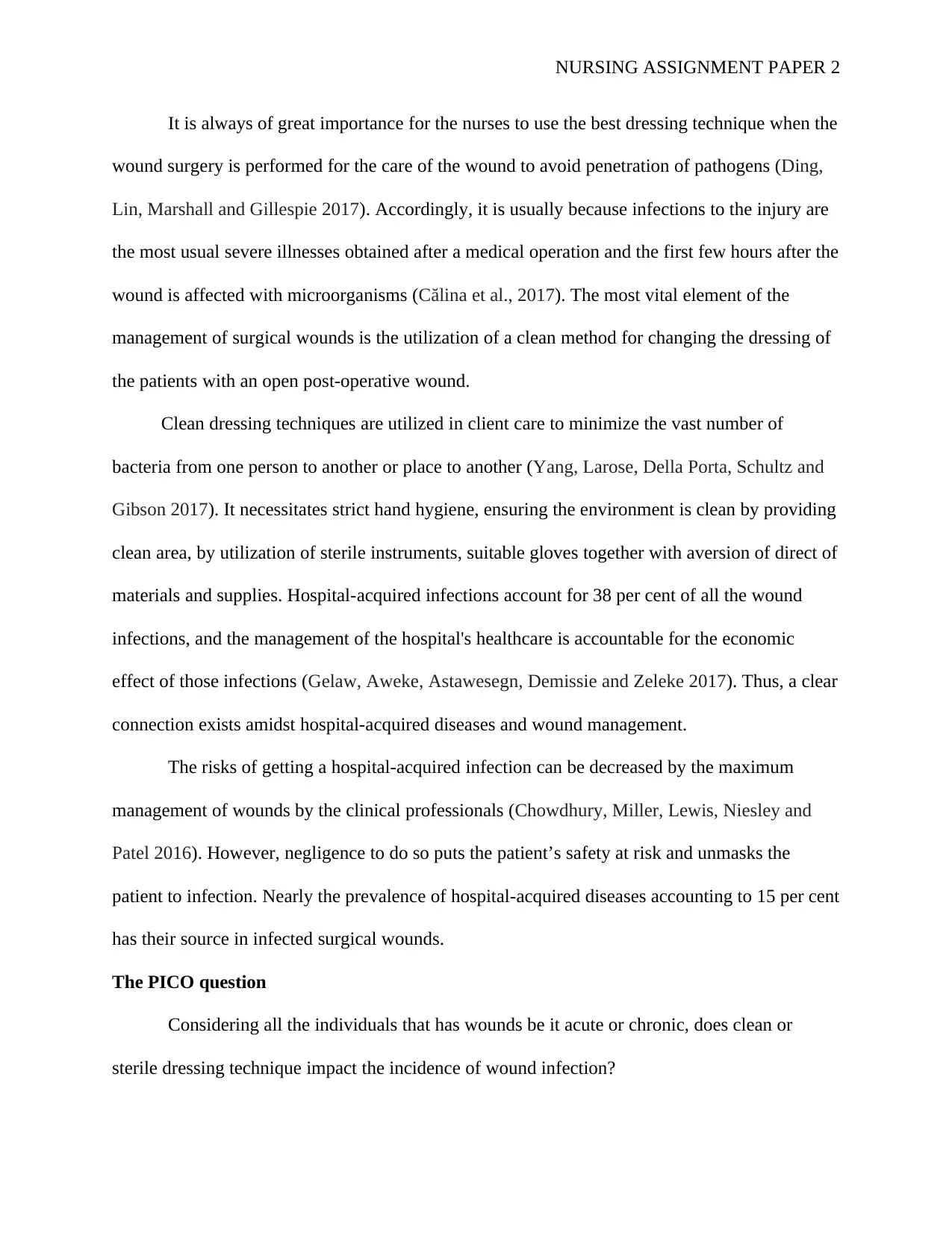
NURSING ASSIGNMENT PAPER 2
It is always of great importance for the nurses to use the best dressing technique when the
wound surgery is performed for the care of the wound to avoid penetration of pathogens (Ding,
Lin, Marshall and Gillespie 2017). Accordingly, it is usually because infections to the injury are
the most usual severe illnesses obtained after a medical operation and the first few hours after the
wound is affected with microorganisms (Călina et al., 2017). The most vital element of the
management of surgical wounds is the utilization of a clean method for changing the dressing of
the patients with an open post-operative wound.
Clean dressing techniques are utilized in client care to minimize the vast number of
bacteria from one person to another or place to another (Yang, Larose, Della Porta, Schultz and
Gibson 2017). It necessitates strict hand hygiene, ensuring the environment is clean by providing
clean area, by utilization of sterile instruments, suitable gloves together with aversion of direct of
materials and supplies. Hospital-acquired infections account for 38 per cent of all the wound
infections, and the management of the hospital's healthcare is accountable for the economic
effect of those infections (Gelaw, Aweke, Astawesegn, Demissie and Zeleke 2017). Thus, a clear
connection exists amidst hospital-acquired diseases and wound management.
The risks of getting a hospital-acquired infection can be decreased by the maximum
management of wounds by the clinical professionals (Chowdhury, Miller, Lewis, Niesley and
Patel 2016). However, negligence to do so puts the patient’s safety at risk and unmasks the
patient to infection. Nearly the prevalence of hospital-acquired diseases accounting to 15 per cent
has their source in infected surgical wounds.
The PICO question
Considering all the individuals that has wounds be it acute or chronic, does clean or
sterile dressing technique impact the incidence of wound infection?
It is always of great importance for the nurses to use the best dressing technique when the
wound surgery is performed for the care of the wound to avoid penetration of pathogens (Ding,
Lin, Marshall and Gillespie 2017). Accordingly, it is usually because infections to the injury are
the most usual severe illnesses obtained after a medical operation and the first few hours after the
wound is affected with microorganisms (Călina et al., 2017). The most vital element of the
management of surgical wounds is the utilization of a clean method for changing the dressing of
the patients with an open post-operative wound.
Clean dressing techniques are utilized in client care to minimize the vast number of
bacteria from one person to another or place to another (Yang, Larose, Della Porta, Schultz and
Gibson 2017). It necessitates strict hand hygiene, ensuring the environment is clean by providing
clean area, by utilization of sterile instruments, suitable gloves together with aversion of direct of
materials and supplies. Hospital-acquired infections account for 38 per cent of all the wound
infections, and the management of the hospital's healthcare is accountable for the economic
effect of those infections (Gelaw, Aweke, Astawesegn, Demissie and Zeleke 2017). Thus, a clear
connection exists amidst hospital-acquired diseases and wound management.
The risks of getting a hospital-acquired infection can be decreased by the maximum
management of wounds by the clinical professionals (Chowdhury, Miller, Lewis, Niesley and
Patel 2016). However, negligence to do so puts the patient’s safety at risk and unmasks the
patient to infection. Nearly the prevalence of hospital-acquired diseases accounting to 15 per cent
has their source in infected surgical wounds.
The PICO question
Considering all the individuals that has wounds be it acute or chronic, does clean or
sterile dressing technique impact the incidence of wound infection?
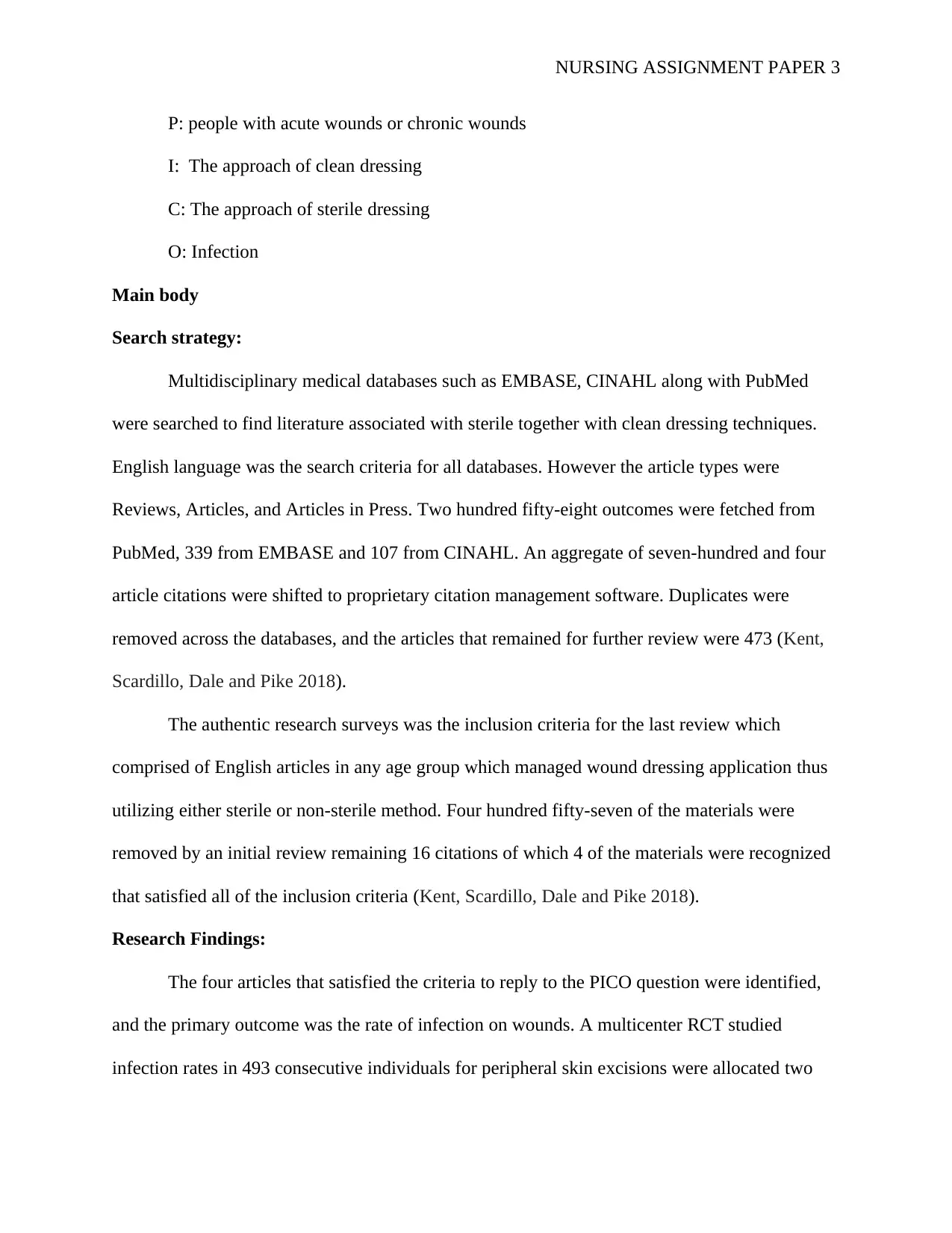
NURSING ASSIGNMENT PAPER 3
P: people with acute wounds or chronic wounds
I: The approach of clean dressing
C: The approach of sterile dressing
O: Infection
Main body
Search strategy:
Multidisciplinary medical databases such as EMBASE, CINAHL along with PubMed
were searched to find literature associated with sterile together with clean dressing techniques.
English language was the search criteria for all databases. However the article types were
Reviews, Articles, and Articles in Press. Two hundred fifty-eight outcomes were fetched from
PubMed, 339 from EMBASE and 107 from CINAHL. An aggregate of seven-hundred and four
article citations were shifted to proprietary citation management software. Duplicates were
removed across the databases, and the articles that remained for further review were 473 (Kent,
Scardillo, Dale and Pike 2018).
The authentic research surveys was the inclusion criteria for the last review which
comprised of English articles in any age group which managed wound dressing application thus
utilizing either sterile or non-sterile method. Four hundred fifty-seven of the materials were
removed by an initial review remaining 16 citations of which 4 of the materials were recognized
that satisfied all of the inclusion criteria (Kent, Scardillo, Dale and Pike 2018).
Research Findings:
The four articles that satisfied the criteria to reply to the PICO question were identified,
and the primary outcome was the rate of infection on wounds. A multicenter RCT studied
infection rates in 493 consecutive individuals for peripheral skin excisions were allocated two
P: people with acute wounds or chronic wounds
I: The approach of clean dressing
C: The approach of sterile dressing
O: Infection
Main body
Search strategy:
Multidisciplinary medical databases such as EMBASE, CINAHL along with PubMed
were searched to find literature associated with sterile together with clean dressing techniques.
English language was the search criteria for all databases. However the article types were
Reviews, Articles, and Articles in Press. Two hundred fifty-eight outcomes were fetched from
PubMed, 339 from EMBASE and 107 from CINAHL. An aggregate of seven-hundred and four
article citations were shifted to proprietary citation management software. Duplicates were
removed across the databases, and the articles that remained for further review were 473 (Kent,
Scardillo, Dale and Pike 2018).
The authentic research surveys was the inclusion criteria for the last review which
comprised of English articles in any age group which managed wound dressing application thus
utilizing either sterile or non-sterile method. Four hundred fifty-seven of the materials were
removed by an initial review remaining 16 citations of which 4 of the materials were recognized
that satisfied all of the inclusion criteria (Kent, Scardillo, Dale and Pike 2018).
Research Findings:
The four articles that satisfied the criteria to reply to the PICO question were identified,
and the primary outcome was the rate of infection on wounds. A multicenter RCT studied
infection rates in 493 consecutive individuals for peripheral skin excisions were allocated two
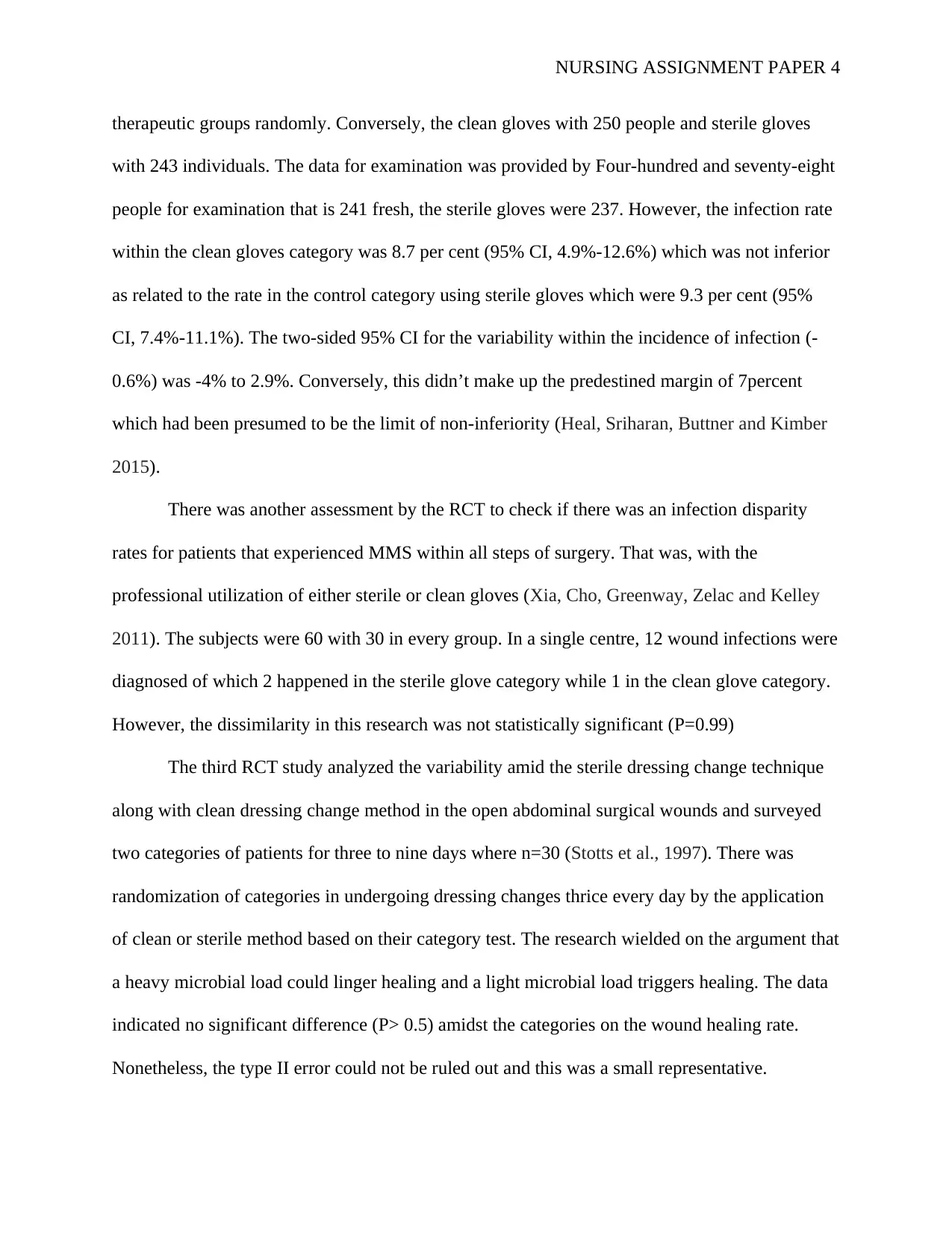
NURSING ASSIGNMENT PAPER 4
therapeutic groups randomly. Conversely, the clean gloves with 250 people and sterile gloves
with 243 individuals. The data for examination was provided by Four-hundred and seventy-eight
people for examination that is 241 fresh, the sterile gloves were 237. However, the infection rate
within the clean gloves category was 8.7 per cent (95% CI, 4.9%-12.6%) which was not inferior
as related to the rate in the control category using sterile gloves which were 9.3 per cent (95%
CI, 7.4%-11.1%). The two-sided 95% CI for the variability within the incidence of infection (-
0.6%) was -4% to 2.9%. Conversely, this didn’t make up the predestined margin of 7percent
which had been presumed to be the limit of non-inferiority (Heal, Sriharan, Buttner and Kimber
2015).
There was another assessment by the RCT to check if there was an infection disparity
rates for patients that experienced MMS within all steps of surgery. That was, with the
professional utilization of either sterile or clean gloves (Xia, Cho, Greenway, Zelac and Kelley
2011). The subjects were 60 with 30 in every group. In a single centre, 12 wound infections were
diagnosed of which 2 happened in the sterile glove category while 1 in the clean glove category.
However, the dissimilarity in this research was not statistically significant (P=0.99)
The third RCT study analyzed the variability amid the sterile dressing change technique
along with clean dressing change method in the open abdominal surgical wounds and surveyed
two categories of patients for three to nine days where n=30 (Stotts et al., 1997). There was
randomization of categories in undergoing dressing changes thrice every day by the application
of clean or sterile method based on their category test. The research wielded on the argument that
a heavy microbial load could linger healing and a light microbial load triggers healing. The data
indicated no significant difference (P> 0.5) amidst the categories on the wound healing rate.
Nonetheless, the type II error could not be ruled out and this was a small representative.
therapeutic groups randomly. Conversely, the clean gloves with 250 people and sterile gloves
with 243 individuals. The data for examination was provided by Four-hundred and seventy-eight
people for examination that is 241 fresh, the sterile gloves were 237. However, the infection rate
within the clean gloves category was 8.7 per cent (95% CI, 4.9%-12.6%) which was not inferior
as related to the rate in the control category using sterile gloves which were 9.3 per cent (95%
CI, 7.4%-11.1%). The two-sided 95% CI for the variability within the incidence of infection (-
0.6%) was -4% to 2.9%. Conversely, this didn’t make up the predestined margin of 7percent
which had been presumed to be the limit of non-inferiority (Heal, Sriharan, Buttner and Kimber
2015).
There was another assessment by the RCT to check if there was an infection disparity
rates for patients that experienced MMS within all steps of surgery. That was, with the
professional utilization of either sterile or clean gloves (Xia, Cho, Greenway, Zelac and Kelley
2011). The subjects were 60 with 30 in every group. In a single centre, 12 wound infections were
diagnosed of which 2 happened in the sterile glove category while 1 in the clean glove category.
However, the dissimilarity in this research was not statistically significant (P=0.99)
The third RCT study analyzed the variability amid the sterile dressing change technique
along with clean dressing change method in the open abdominal surgical wounds and surveyed
two categories of patients for three to nine days where n=30 (Stotts et al., 1997). There was
randomization of categories in undergoing dressing changes thrice every day by the application
of clean or sterile method based on their category test. The research wielded on the argument that
a heavy microbial load could linger healing and a light microbial load triggers healing. The data
indicated no significant difference (P> 0.5) amidst the categories on the wound healing rate.
Nonetheless, the type II error could not be ruled out and this was a small representative.
Secure Best Marks with AI Grader
Need help grading? Try our AI Grader for instant feedback on your assignments.
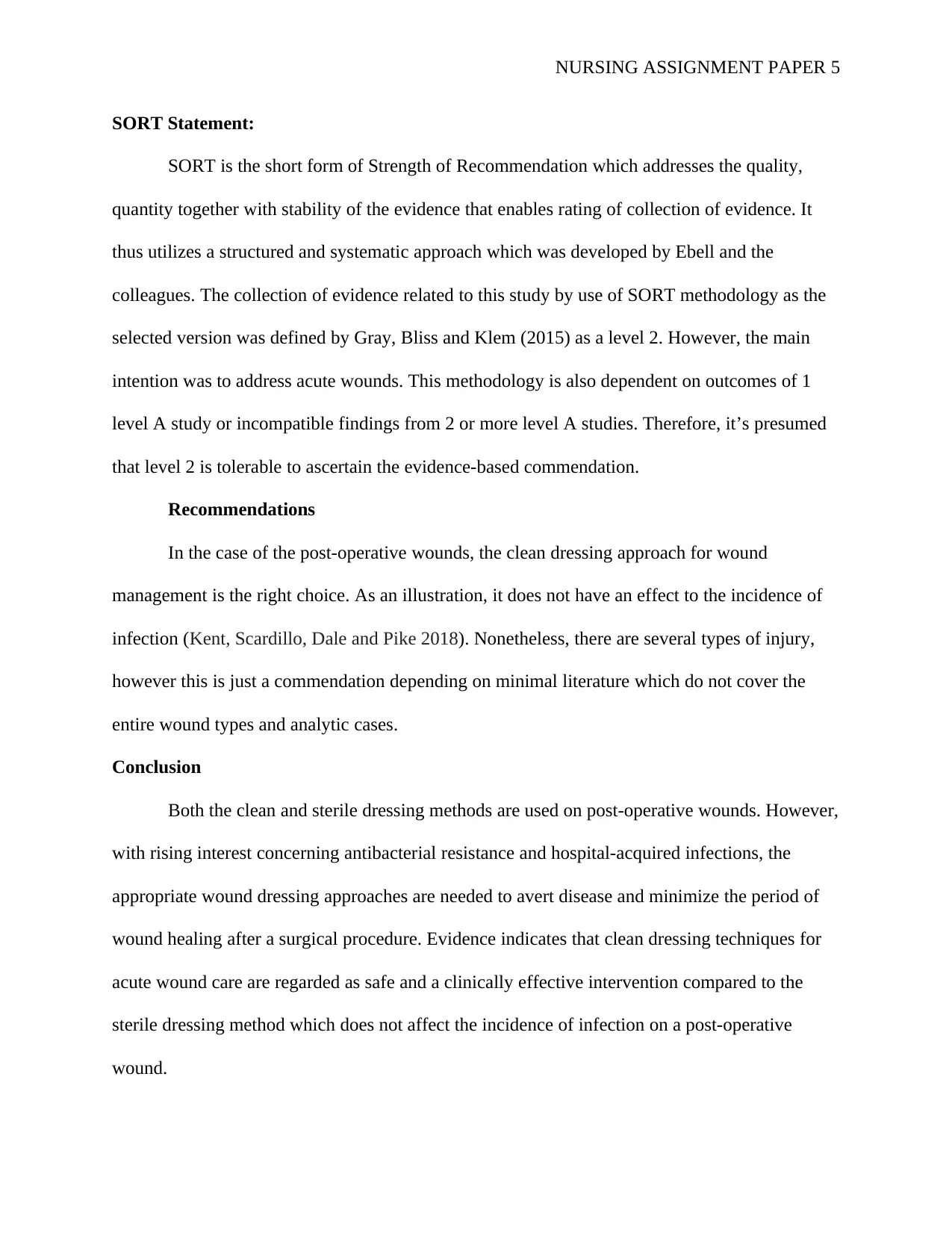
NURSING ASSIGNMENT PAPER 5
SORT Statement:
SORT is the short form of Strength of Recommendation which addresses the quality,
quantity together with stability of the evidence that enables rating of collection of evidence. It
thus utilizes a structured and systematic approach which was developed by Ebell and the
colleagues. The collection of evidence related to this study by use of SORT methodology as the
selected version was defined by Gray, Bliss and Klem (2015) as a level 2. However, the main
intention was to address acute wounds. This methodology is also dependent on outcomes of 1
level A study or incompatible findings from 2 or more level A studies. Therefore, it’s presumed
that level 2 is tolerable to ascertain the evidence-based commendation.
Recommendations
In the case of the post-operative wounds, the clean dressing approach for wound
management is the right choice. As an illustration, it does not have an effect to the incidence of
infection (Kent, Scardillo, Dale and Pike 2018). Nonetheless, there are several types of injury,
however this is just a commendation depending on minimal literature which do not cover the
entire wound types and analytic cases.
Conclusion
Both the clean and sterile dressing methods are used on post-operative wounds. However,
with rising interest concerning antibacterial resistance and hospital-acquired infections, the
appropriate wound dressing approaches are needed to avert disease and minimize the period of
wound healing after a surgical procedure. Evidence indicates that clean dressing techniques for
acute wound care are regarded as safe and a clinically effective intervention compared to the
sterile dressing method which does not affect the incidence of infection on a post-operative
wound.
SORT Statement:
SORT is the short form of Strength of Recommendation which addresses the quality,
quantity together with stability of the evidence that enables rating of collection of evidence. It
thus utilizes a structured and systematic approach which was developed by Ebell and the
colleagues. The collection of evidence related to this study by use of SORT methodology as the
selected version was defined by Gray, Bliss and Klem (2015) as a level 2. However, the main
intention was to address acute wounds. This methodology is also dependent on outcomes of 1
level A study or incompatible findings from 2 or more level A studies. Therefore, it’s presumed
that level 2 is tolerable to ascertain the evidence-based commendation.
Recommendations
In the case of the post-operative wounds, the clean dressing approach for wound
management is the right choice. As an illustration, it does not have an effect to the incidence of
infection (Kent, Scardillo, Dale and Pike 2018). Nonetheless, there are several types of injury,
however this is just a commendation depending on minimal literature which do not cover the
entire wound types and analytic cases.
Conclusion
Both the clean and sterile dressing methods are used on post-operative wounds. However,
with rising interest concerning antibacterial resistance and hospital-acquired infections, the
appropriate wound dressing approaches are needed to avert disease and minimize the period of
wound healing after a surgical procedure. Evidence indicates that clean dressing techniques for
acute wound care are regarded as safe and a clinically effective intervention compared to the
sterile dressing method which does not affect the incidence of infection on a post-operative
wound.
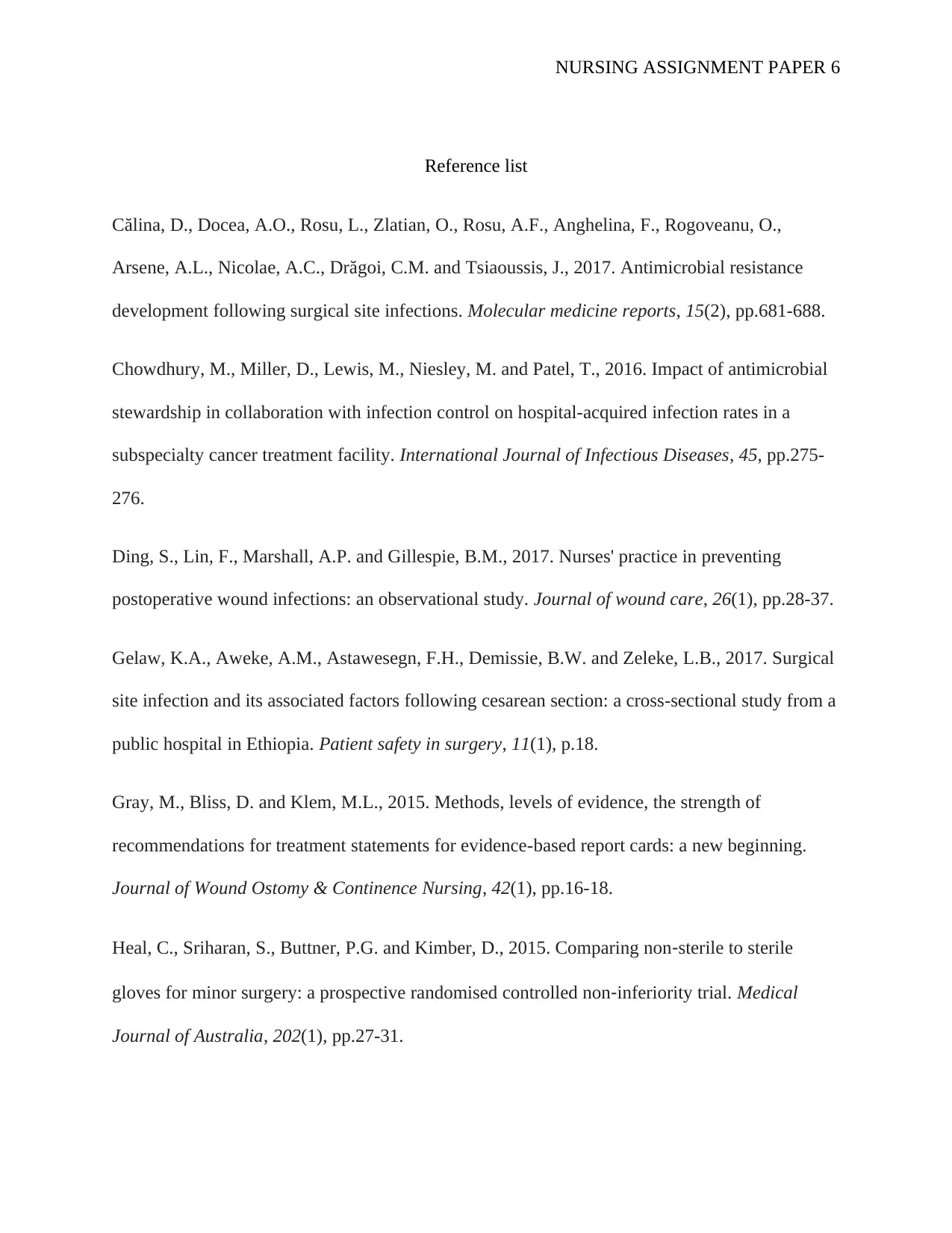
NURSING ASSIGNMENT PAPER 6
Reference list
Călina, D., Docea, A.O., Rosu, L., Zlatian, O., Rosu, A.F., Anghelina, F., Rogoveanu, O.,
Arsene, A.L., Nicolae, A.C., Drăgoi, C.M. and Tsiaoussis, J., 2017. Antimicrobial resistance
development following surgical site infections. Molecular medicine reports, 15(2), pp.681-688.
Chowdhury, M., Miller, D., Lewis, M., Niesley, M. and Patel, T., 2016. Impact of antimicrobial
stewardship in collaboration with infection control on hospital-acquired infection rates in a
subspecialty cancer treatment facility. International Journal of Infectious Diseases, 45, pp.275-
276.
Ding, S., Lin, F., Marshall, A.P. and Gillespie, B.M., 2017. Nurses' practice in preventing
postoperative wound infections: an observational study. Journal of wound care, 26(1), pp.28-37.
Gelaw, K.A., Aweke, A.M., Astawesegn, F.H., Demissie, B.W. and Zeleke, L.B., 2017. Surgical
site infection and its associated factors following cesarean section: a cross-sectional study from a
public hospital in Ethiopia. Patient safety in surgery, 11(1), p.18.
Gray, M., Bliss, D. and Klem, M.L., 2015. Methods, levels of evidence, the strength of
recommendations for treatment statements for evidence-based report cards: a new beginning.
Journal of Wound Ostomy & Continence Nursing, 42(1), pp.16-18.
Heal, C., Sriharan, S., Buttner, P.G. and Kimber, D., 2015. Comparing non‐sterile to sterile
gloves for minor surgery: a prospective randomised controlled non‐inferiority trial. Medical
Journal of Australia, 202(1), pp.27-31.
Reference list
Călina, D., Docea, A.O., Rosu, L., Zlatian, O., Rosu, A.F., Anghelina, F., Rogoveanu, O.,
Arsene, A.L., Nicolae, A.C., Drăgoi, C.M. and Tsiaoussis, J., 2017. Antimicrobial resistance
development following surgical site infections. Molecular medicine reports, 15(2), pp.681-688.
Chowdhury, M., Miller, D., Lewis, M., Niesley, M. and Patel, T., 2016. Impact of antimicrobial
stewardship in collaboration with infection control on hospital-acquired infection rates in a
subspecialty cancer treatment facility. International Journal of Infectious Diseases, 45, pp.275-
276.
Ding, S., Lin, F., Marshall, A.P. and Gillespie, B.M., 2017. Nurses' practice in preventing
postoperative wound infections: an observational study. Journal of wound care, 26(1), pp.28-37.
Gelaw, K.A., Aweke, A.M., Astawesegn, F.H., Demissie, B.W. and Zeleke, L.B., 2017. Surgical
site infection and its associated factors following cesarean section: a cross-sectional study from a
public hospital in Ethiopia. Patient safety in surgery, 11(1), p.18.
Gray, M., Bliss, D. and Klem, M.L., 2015. Methods, levels of evidence, the strength of
recommendations for treatment statements for evidence-based report cards: a new beginning.
Journal of Wound Ostomy & Continence Nursing, 42(1), pp.16-18.
Heal, C., Sriharan, S., Buttner, P.G. and Kimber, D., 2015. Comparing non‐sterile to sterile
gloves for minor surgery: a prospective randomised controlled non‐inferiority trial. Medical
Journal of Australia, 202(1), pp.27-31.
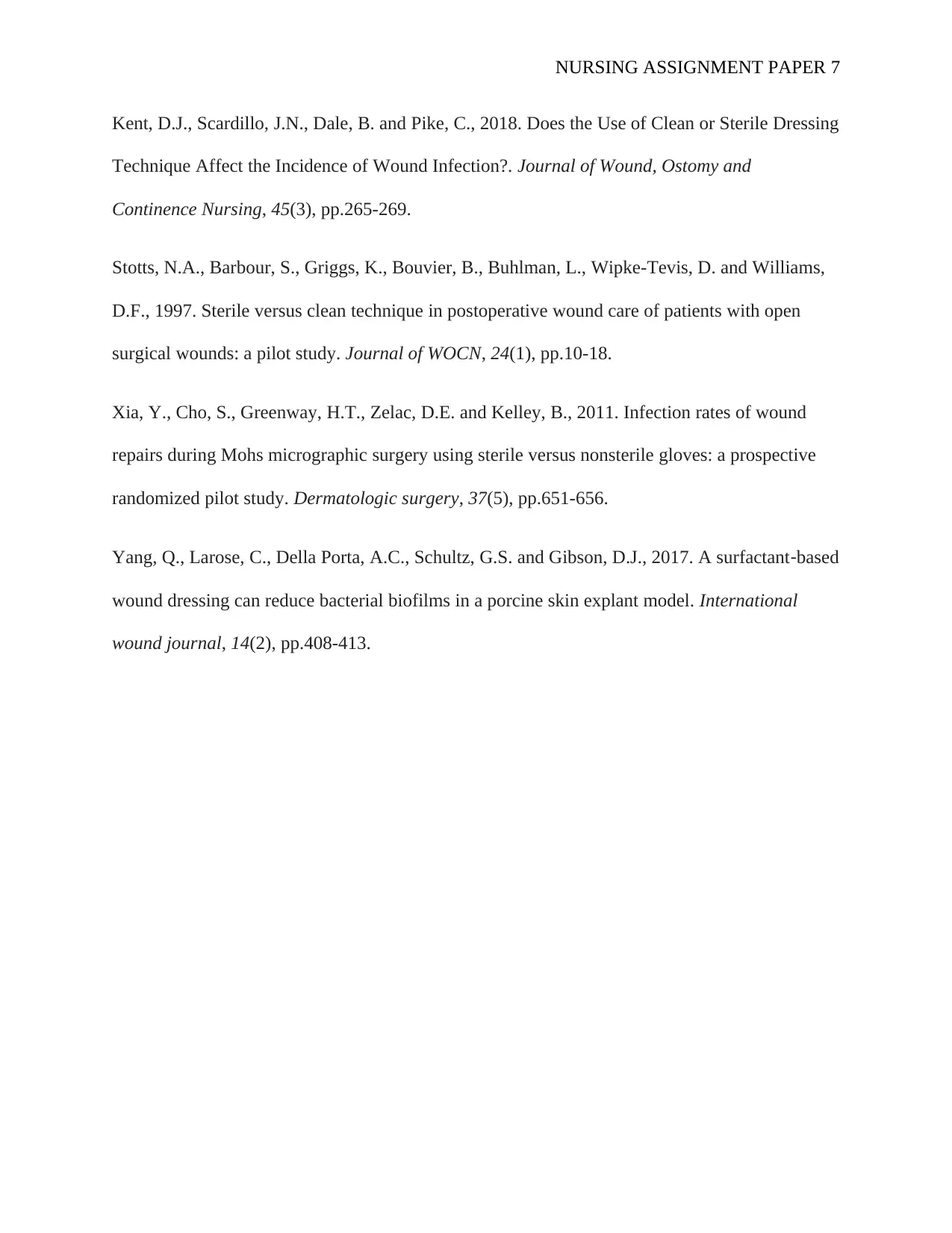
NURSING ASSIGNMENT PAPER 7
Kent, D.J., Scardillo, J.N., Dale, B. and Pike, C., 2018. Does the Use of Clean or Sterile Dressing
Technique Affect the Incidence of Wound Infection?. Journal of Wound, Ostomy and
Continence Nursing, 45(3), pp.265-269.
Stotts, N.A., Barbour, S., Griggs, K., Bouvier, B., Buhlman, L., Wipke-Tevis, D. and Williams,
D.F., 1997. Sterile versus clean technique in postoperative wound care of patients with open
surgical wounds: a pilot study. Journal of WOCN, 24(1), pp.10-18.
Xia, Y., Cho, S., Greenway, H.T., Zelac, D.E. and Kelley, B., 2011. Infection rates of wound
repairs during Mohs micrographic surgery using sterile versus nonsterile gloves: a prospective
randomized pilot study. Dermatologic surgery, 37(5), pp.651-656.
Yang, Q., Larose, C., Della Porta, A.C., Schultz, G.S. and Gibson, D.J., 2017. A surfactant‐based
wound dressing can reduce bacterial biofilms in a porcine skin explant model. International
wound journal, 14(2), pp.408-413.
Kent, D.J., Scardillo, J.N., Dale, B. and Pike, C., 2018. Does the Use of Clean or Sterile Dressing
Technique Affect the Incidence of Wound Infection?. Journal of Wound, Ostomy and
Continence Nursing, 45(3), pp.265-269.
Stotts, N.A., Barbour, S., Griggs, K., Bouvier, B., Buhlman, L., Wipke-Tevis, D. and Williams,
D.F., 1997. Sterile versus clean technique in postoperative wound care of patients with open
surgical wounds: a pilot study. Journal of WOCN, 24(1), pp.10-18.
Xia, Y., Cho, S., Greenway, H.T., Zelac, D.E. and Kelley, B., 2011. Infection rates of wound
repairs during Mohs micrographic surgery using sterile versus nonsterile gloves: a prospective
randomized pilot study. Dermatologic surgery, 37(5), pp.651-656.
Yang, Q., Larose, C., Della Porta, A.C., Schultz, G.S. and Gibson, D.J., 2017. A surfactant‐based
wound dressing can reduce bacterial biofilms in a porcine skin explant model. International
wound journal, 14(2), pp.408-413.
Paraphrase This Document
Need a fresh take? Get an instant paraphrase of this document with our AI Paraphraser
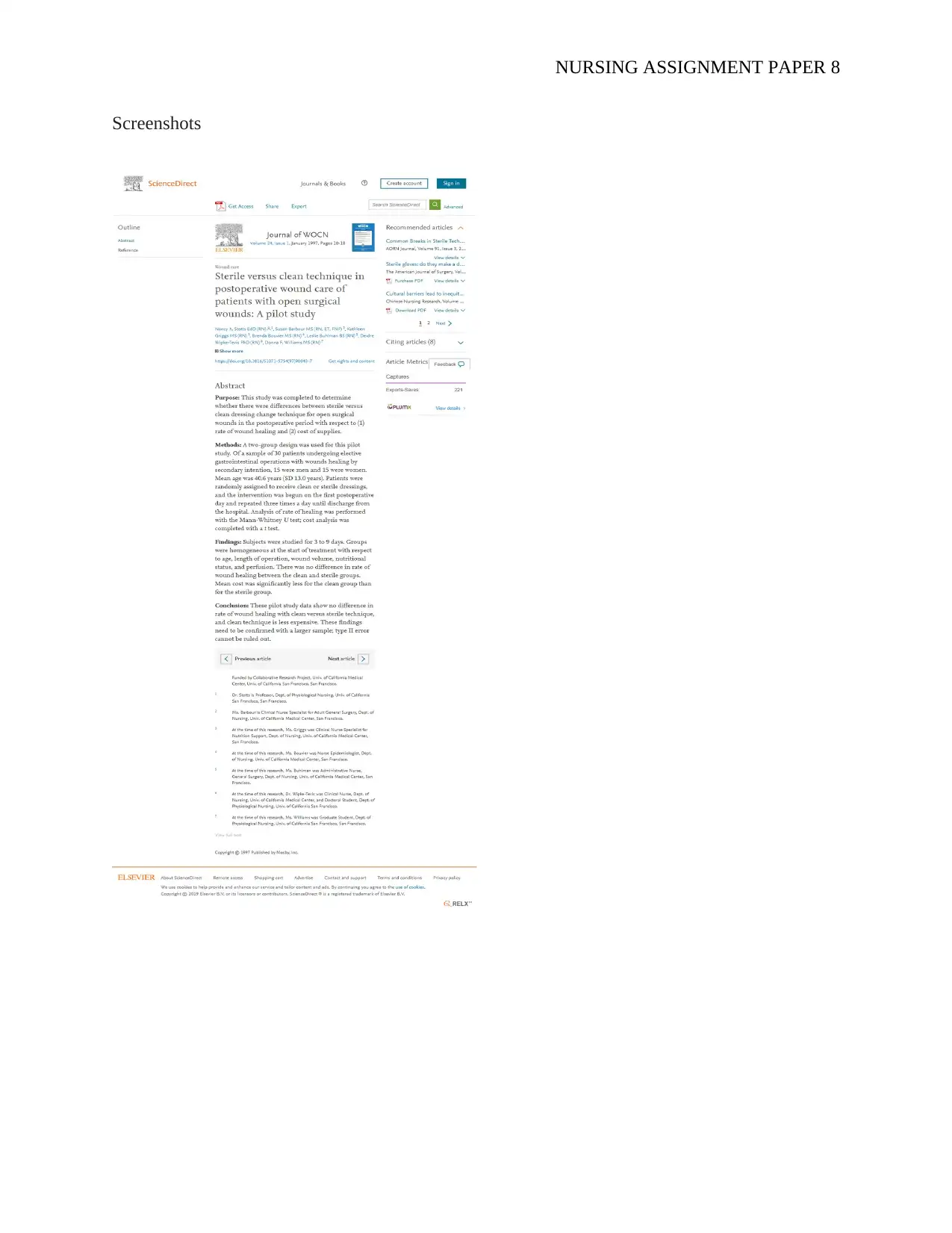
NURSING ASSIGNMENT PAPER 8
Screenshots
Screenshots
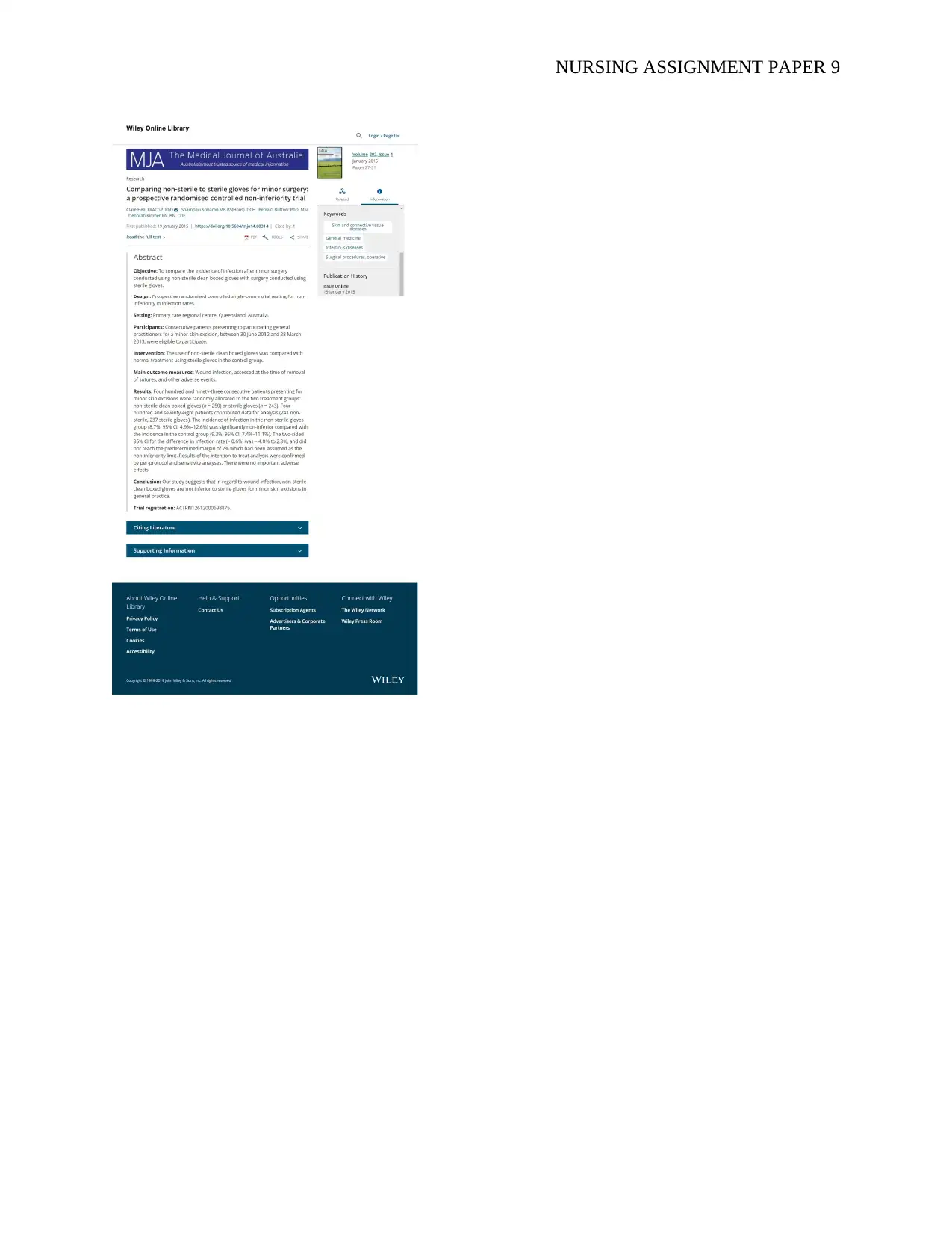
NURSING ASSIGNMENT PAPER 9
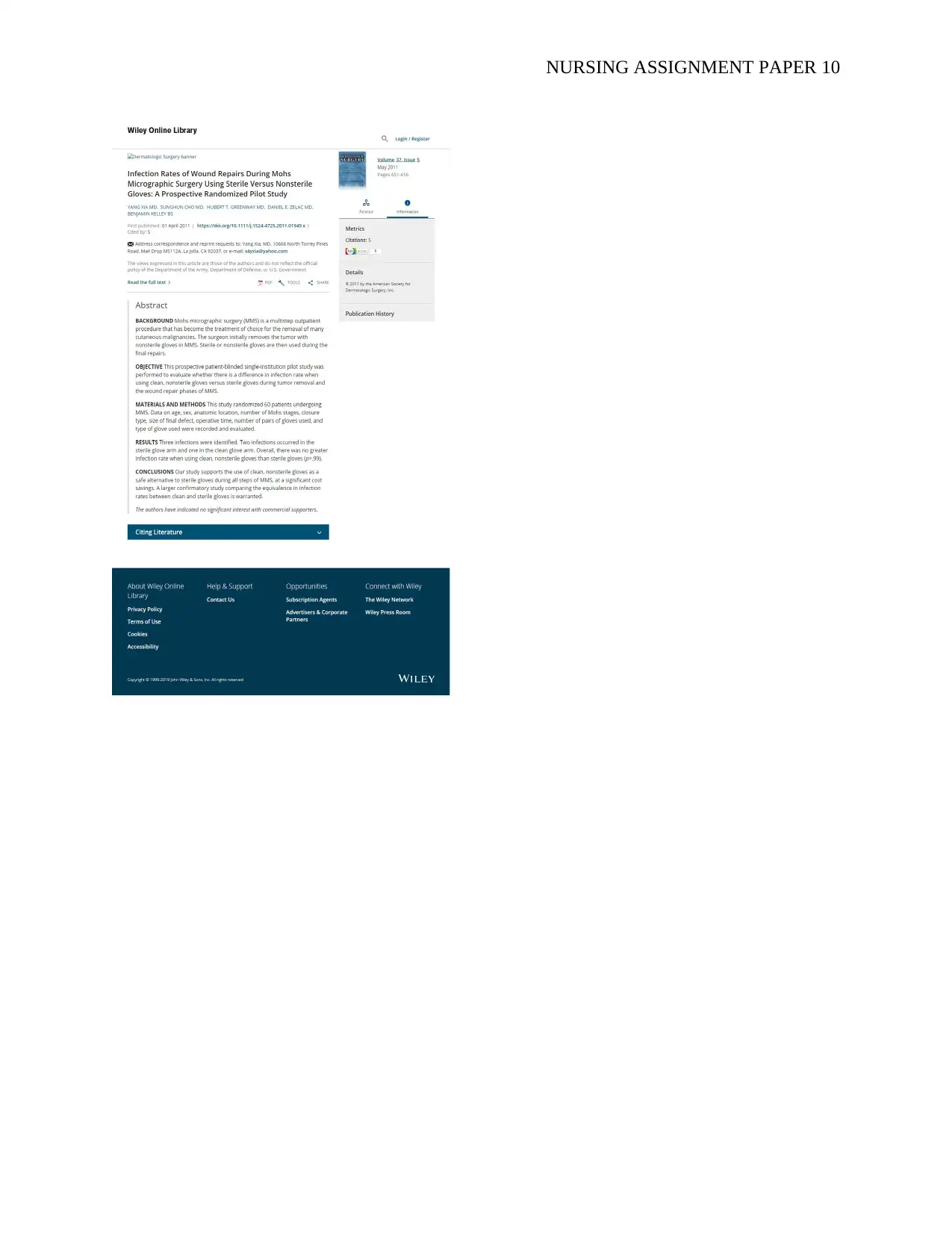
NURSING ASSIGNMENT PAPER 10
1 out of 10
Related Documents
Your All-in-One AI-Powered Toolkit for Academic Success.
+13062052269
info@desklib.com
Available 24*7 on WhatsApp / Email
![[object Object]](/_next/static/media/star-bottom.7253800d.svg)
Unlock your academic potential
© 2024 | Zucol Services PVT LTD | All rights reserved.





